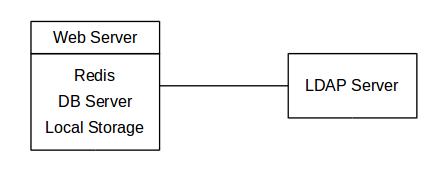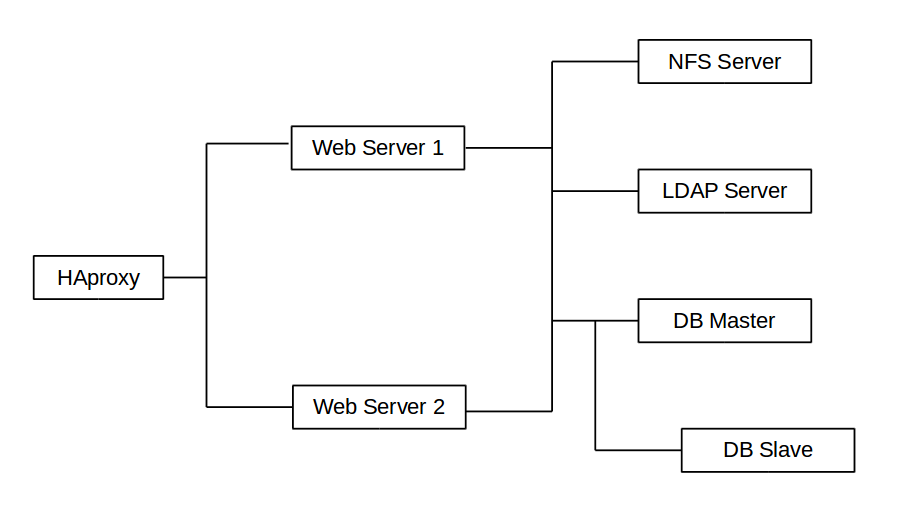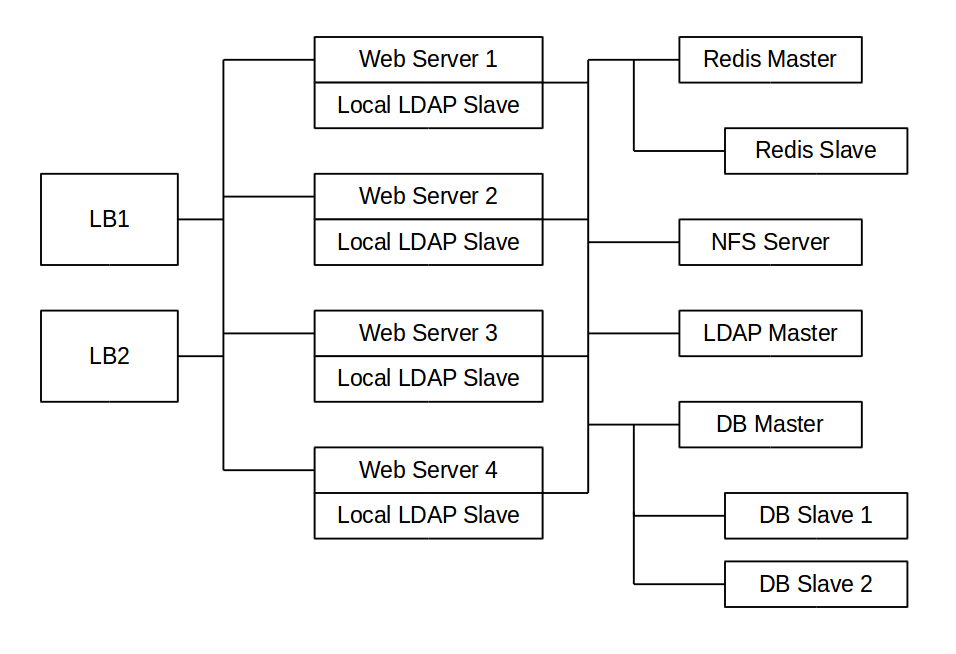Deployment Recommendations¶
What is the best way to install and maintain ownCloud? The answer to that is, as always: “it depends”.
This is because every ownCloud customer has their own particular needs and IT infrastructure. However, both ownCloud and the LAMP stack are highly-configurable. Given that, in this document we present a set of general recommendations, followed by three typical scenarios, and finish up with making best-practice recommendations for both software and hardware.
Note
The recommendations presented here are based on a standard ownCloud installation, one without any particular apps, themes, or code changes. But, server load is dependent upon the number of clients, files, and user activity, as well as other usage patterns. Given that, these recommendations are only a rule of thumb based on our experience, as well as that of one of our customers.
General Recommendations¶
- Operating system: Linux.
- Web server: Apache 2.4.
- Database: MySQL/MariaDB with InnoDB storage engine (MyISAM is not supported, see: MySQL / MariaDB storage engine)
- PHP 5.6+.
- Consider setting up a scale-out deployment, or using Federated Cloud Sharing to keep individual ownCloud instances to a manageable size.
Note
Whatever the size of your organization, always keep one thing in mind: The amount of data stored in ownCloud will only grow. So plan ahead.
Scenario 1: Small Workgroups and Departments¶
This recommendation applies if you meet the following criteria:
| Option | Value |
|---|---|
| Number of users | Up to 150 users |
| Storage size | 100 GB to 10TB |
| High availability level | Zero-downtime backups via Btrfs snapshots, component failure leads to interruption of service. Alternate backup scheme on other filesystems: nightly backups — with service interruption. |
Recommended System Requirements¶
One machine running the application, web, and database server, as well as local storage. Authentication via an existing LDAP or Active Directory server.

Components¶
One server with at least 2 CPU cores, 16GB RAM, and local storage as needed.
Operating system¶
Enterprise-grade Linux distribution with full support from an operating system vendor. We recommend both RedHat Enterprise Linux and SUSE Linux Enterprise Server 12.
SSL Configuration¶
The SSL termination is done in Apache. A standard SSL certificate is required to be installed according to the official Apache documentation.
Load Balancer¶
None.
Database¶
MySQL, MariaDB, or PostgreSQL. We currently recommend MySQL / MariaDB, as our customers have had good experiences when moving to a Galera cluster to scale the DB. If using either MySQL or MariaDB, you must use the InnoDB storage engine as MyISAM is not supported, see: MySQL / MariaDB storage engine
Warning
If you are using MaxScale/Galera, then you need to use at least version 1.3.0. In earlier versions, there is a bug where the value of
last_insert_idis not routed to the master node. This bug can cause loops within ownCloud and corrupt database rows. You can find out more information in the issue documentation.
Backup¶
Install ownCloud, the ownCloud data directory, and database on a Btrfs filesystem. Make regular snapshots at desired intervals for zero downtime backups. Mount DB partitions with the “nodatacow” option to prevent fragmentation.
Alternatively, you can make nightly backups — with service interruption — as follows:
- Shut down Apache.
- Create database dump.
- Push data directory to backup.
- Push database dump to backup.
- Start Apache.
After these steps have been completed, then, optionally, rsync the backup to either an external backup storage or tape backup. See the Maintenance section of the Administration manual for tips on backups and restores.
Authentication¶
User authentication via one or several LDAP or Active Directory (AD) servers. See User Authentication with LDAP for information on configuring ownCloud to use LDAP and AD.
Session Management¶
Local session management on the application server.
PHP sessions are stored in a temporary filesystem, mounted at the operating system-specific session storage location.
You can find out where that is by running grep -R 'session.save_path' /etc/php5 and then add it to the /etc/fstab file, for example:
echo "tmpfs /var/lib/php5/pool-www tmpfs defaults,noatime,mode=1777 0 0" >> /etc/fstab``.
Memory Caching¶
A memory cache speeds up server performance, and ownCloud supports four of them. Refer to Configuring Memory Caching for information on selecting and configuring a memory cache.
Storage¶
Local storage.
ownCloud Edition¶
Standard Edition. See ownCloud Server or Enterprise Edition for comparisons of the ownCloud editions.
Scenario 2: Mid-Sized Enterprises¶
These recommendations apply if you meet the following criteria:
| Option | Value |
|---|---|
| Number of users | 150 to 1,000 users. |
| Storage size | Up to 200TB. |
| High availability level | Every component is fully redundant and can fail without service interruption. Backups without service interruption |
Recommended System Requirements¶
- 2 to 4 application servers.
- A cluster of two database servers.
- Storage on an NFS server.
- Authentication via an existing LDAP or Active Directory server.

Components¶
- 2 to 4 application servers with four sockets and 32GB RAM.
- 2 DB servers with four sockets and 64GB RAM.
- 1 HAproxy load balancer with two sockets and 16GB RAM.
- NFS storage server as needed.
Operating System¶
Enterprise grade Linux distribution with full support from an operating system vendor. We recommend both RedHat Enterprise Linux and SUSE Linux Enterprise Server 12.
SSL Configuration¶
The SSL termination is done in the HAProxy load balancer. A standard SSL certificate is needed, installed according to the HAProxy documentation.
Load Balancer¶
HAProxy running on a dedicated server in front of the application servers. Sticky session needs to be used because of local session management on the application servers.
Database¶
MySQL/MariaDB Galera cluster with master-master replication. InnoDB storage engine, MyISAM is not supported, see: MySQL / MariaDB storage engine.
Backup¶
Minimum daily backup without downtime. All MySQL/MariaDB statements should be replicated to a backup MySQL/MariaDB slave instance.
- Create a snapshot on the NFS storage server.
- At the same time stop the MySQL replication.
- Create a MySQL dump of the backup slave.
- Push the NFS snapshot to the backup.
- Push the MySQL dump to the backup.
- Delete the NFS snapshot.
- Restart MySQL replication.
Authentication¶
User authentication via one or several LDAP or Active Directory servers. See User Authentication with LDAP for information on configuring ownCloud to use LDAP and AD.
Session Management¶
Session management on the application server.
PHP sessions are stored in a temporary filesystem, mounted at the operating system-specific session storage location.
You can find out where that is by running grep -R 'session.save_path' /etc/php5 and then add it to the /etc/fstab file, for example:
echo "tmpfs /var/lib/php5/pool-www tmpfs defaults,noatime,mode=1777 0 0" >> /etc/fstab
Memory Caching¶
A memory cache speeds up server performance, and ownCloud supports four memory cache types. Refer to Configuring Memory Caching for information on selecting and configuring a memory cache.
Storage¶
Use an off-the-shelf NFS solution, such as IBM Elastic Storage or RedHat Ceph.
ownCloud Edition¶
Enterprise Edition. See ownCloud Server or Enterprise Edition for comparisons of the ownCloud editions.
Scenario 3: Large Enterprises and Service Providers¶
| Option | Value |
|---|---|
| Number of users | 5,000 to >100,000 users. |
| Storage size | Up to 1 petabyte. |
| High availability level | Every component is fully redundant and can fail without service interruption. Backups without service interruption. |
Recommended System Requirements¶
- 4 to 20 application/Web servers.
- A cluster of two or more database servers.
- Storage is an NFS server or an object store that is S3 compatible.
- Cloud federation for a distributed setup over several data centers.
- Authentication via an existing LDAP or Active Directory server, or SAML.
Components¶
- 4 to 20 application servers with four sockets and 64GB RAM.
- 4 DB servers with four sockets and 128GB RAM.
- 2 Hardware load balancer, for example, BIG IP from F5.
- NFS storage server as needed.
Operating system¶
RHEL 7 with latest service packs.
SSL Configuration¶
The SSL termination is done in the load balancer. A standard SSL certificate is needed, installed according to the load balancer documentation.
Load Balancer¶
A redundant hardware load-balancer with heartbeat, for example, F5 Big-IP. This runs two load balancers in front of the application servers.
Database¶
MySQL/MariaDB Galera Cluster with 4x master-master replication. InnoDB storage engine, MyISAM is not supported, see: MySQL / MariaDB storage engine.
Backup¶
Minimum daily backup without downtime. All MySQL/MariaDB statements should be replicated to a backup MySQL/MariaDB slave instance. To do this, follow these steps:
- Create a snapshot on the NFS storage server.
- At the same time stop the MySQL replication.
- Create a MySQL dump of the backup slave.
- Push the NFS snapshot to the backup.
- Push the MySQL dump to the backup.
- Delete the NFS snapshot.
- Restart MySQL replication.
Authentication¶
User authentication via one or several LDAP or Active Directory servers, or SAML/Shibboleth. See User Authentication with LDAP and Shibboleth Integration.
LDAP¶
Read-only slaves should be deployed on every application server for optimal scalability.
Caching¶
Redis for distributed in-memory caching, see Configuring Memory Caching.
Storage¶
An off-the-shelf NFS solution should be used. Some examples are IBM Elastic Storage or RedHat Ceph. Optionally, an S3 compatible object store can also be used.
ownCloud Edition¶
Enterprise Edition. See ownCloud Server or Enterprise Edition for comparisons of the ownCloud editions.
Redis Configuration¶
Redis in a master-slave configuration is a hot failover setup, and is usually sufficient. A slave can be omitted if high availability is provided via other means. And when it is, in the event of a failure, restarting Redis typically occurs quickly enough. Regarding Redis cluster, we don’t, usually, recommend it, as it requires a greater level of both maintenance and management in the case of failure. A single Redis server, however, just needs to be rebooted, in the event of failure.
Known Issues¶
Deadlocks When Using MariaDB Galera Cluster¶
If you’re using MariaDB Galera Cluster with your ownCloud installation, you may encounter deadlocks when you attempt to sync a large number of files. You may also encounter database errors, such as this one:
SQLSTATE[40001]: Serialization failure: 1213 Deadlock found when trying to get lock; try restarting transaction
The issue, identified by Michael Roth, is caused when MariaDB Galera cluster sends write requests to all servers in the cluster; here is a detailed explanation. The solution is to send all write requests to a single server, instead of all of them.
